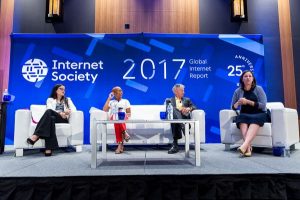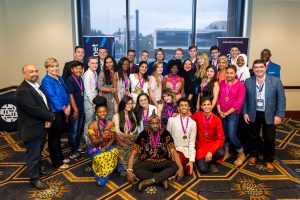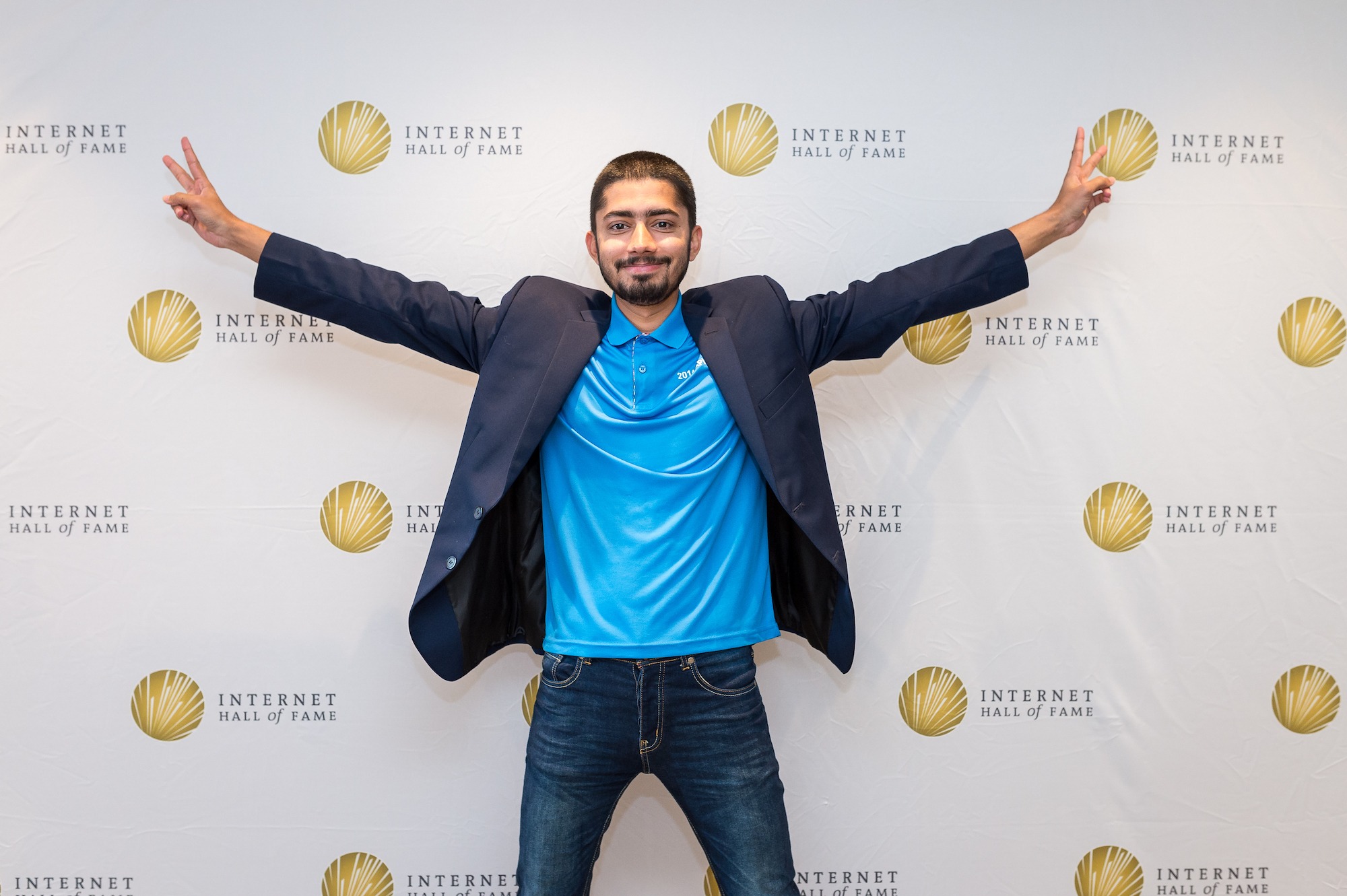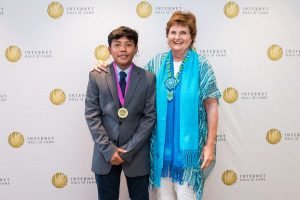In September 2017, the Internet Society celebrated its 25th anniversary in Los Angeles. Here are the stories of some who are using the Internet to shape tomorrow.
“I made my first computer program at 18 and it felt like I had a new superpower.”
To get to the buzzing banquet hall where Akah Harvey N stands, filled with Internet pioneers, visionaries, and trailblazers, requires navigating the University of California Los Angeles (UCLA) Athletics Hall of Fame. Glass cases featuring old sequined spirit uniforms and uniforms worn by Jackie Robinson (the first athlete to letter in four sports at the university) line the way to the room where people from around the world are seated at tables, excitedly chatting away.
Harvey N is at the front of the room, speaking into the microphone like he belongs there. And that’s because he does. The 25-year-old from Cameroon is in Los Angeles, California to be recognized as one of the Internet Society’s 25 Under 25 – young people who are using the Internet as a force for good. Harvey N and his team of engineers developed Traveler, an app that can predict and detect motor vehicle accidents. Along with providing real time information on how a car is driving, the app can connect to emergency response services in the case of an accident. He’s an honored guest alongside some of the biggest names in the history of the Internet, people he’s never met before today and who are being inducted into the Internet Hall of Fame.
For perhaps the very first time, the past and future of the Internet are in one room.
This is the 25th anniversary celebration of the Internet Society, and a bridging of generations of changemakers. For perhaps the very first time, the past and future of the Internet are in one room. On one end of the spectrum are the people who created the technology we use today, the nitty gritty building blocks required to make the Internet work. At the other end are the young people like Harvey N, who are taking that technology out into the world and using it to create change in ways its originators never could have imagined.
The Internet Society has brought these two groups of people together – gathered them from all over the world – to paint a full picture of this technology that we use every day. The people who are passionate about the technology itself get to meet the people who are passionate about what that technology is capable of doing. In a very real way, these people who changed the world get to see just how much – to have a tangible understanding and vision of the impact their work has had on the current generation of people who are using it.
It is not often that the entire history of anything is in a room together.
What these two groups have in common is a vision of the world in which anything is possible, an ability to move beyond what exists and to imagine what could be. They share an enthusiasm for a world with boundless possibilities, one where they see a problem and envision a solution. And they all had the wherewithal to make it happen.
It is not often that the entire history of anything is in a room together. It is special. Everyone here understands this and the electric chatter that fills the room makes it clear. The other thing that is clear: people are at the center of this infinite web of networks and routers and fiber optic cables. People built this network from nothing and now they are expanding it at lightning speed.
The Internet Hall of Fame was started by the Internet Society in 2012. It is a virtual museum that recognizes the pioneers of the Internet, the people who brought this indispensable technology to life. The thing about the Internet is that most everyone knows that email is routed using domain names, but most people would be hard pressed to tell you whose idea it was in the first place. The answer, attendees to this year’s Internet Hall of Fame Induction Ceremony learned, is Craig Partridge, who described his experience as “being the guy who found a bug and, therefore, was tasked with trying to fix it.” Partridge expressed a humility heard often at our anniversary gathering, and one that was essential to the early days of the Internet. Dr. Douglas Van Houweling, 2014 Internet Hall of Fame inductee, described it by saying, “We figured out that you could get a lot accomplished if you didn’t care about taking credit.”
From its inception, the Internet has been about community. It’s been about people from all over the world working together to build something bigger than themselves. When he got up to the podium to give his induction speech, innovator Alan Emtage, who conceived and implemented Archie – the first search engine – said it was a conscious decision not to patent it because it would inhibit people’s ability to develop the technology further. “It was done in the spirit of collaboration,” he said. “Without that spirit of altruism, the Internet would not exist.”
…the spirit of altruism that led to creditless collaboration to build the Internet can all-too-easily become an erasure of history.
While accepting his Lifetime Achievement Award, Steve Crocker shared that the first slogan for the ARPANET – a precursor to what we know as the Internet today – was “a network to bring people together.” That spirit has continued today, as the 25 Under 25 use the technology to bridge gaps, make change, and build community. But as the Internet has become mainstream, reaching over 50% penetration worldwide, the spirit of altruism that led to creditless collaboration to build the Internet can all-too-easily become an erasure of history. That’s where the Internet Hall of Fame comes in, giving credit where credit is due and providing a catalogue of the trailblazers of the technology that changed the world and built a society.
In Los Angeles, where the Internet Hall of Fame and 25 Under 25 award ceremonies took place, that history came face-to-face with the future. Ash Ball, a 25 Under 25-er from Australia was all-too-aware of the fact that he was among the greats. “I’ve only experienced the world with the Internet,” the 23-year-old who has launched an anti-cyberbullying youth movement said. “The job I get to do every day is because you created a platform that allows kindness and change to flourish.”
The Internet Society was created in 1992 by Vint Cerf and Bob Kahn with the express purpose of fostering collaboration, facilitating the technical evolution of the Internet, and educating and advocating on its behalf. At the time, says Cerf, the scientific field no longer wanted to use funds on Internet research. But these pioneers recognized that it was technology worthy of and requiring documentation and tracking.
When the Internet Society was started, its founders would have had no way of knowing what the organization would accomplish, or where the Internet would one day go. But creation of anything is like that; you unleash an idea into the world and then let go of control over what others do with it. The pioneers of the Internet did envision it as a way for networks of computers – and people – to communicate with each other. But could they have foreseen the kinds of social networks and global communication structures that users and developers would one day implement? Who could have?
“The Internet has always surprised us in its application,” says Dr. Leonard Kleinrock, Distinguished Professor of Computer Science at the UCLA School of Engineering and Applied Science, one of the pioneers of the Internet, and a member of the Internet Hall of Fame.
 “You don’t realize just how subversive some of this stuff was.”
“You don’t realize just how subversive some of this stuff was.”
Despite the fact that these young people use the Internet in various capacities every day – from coding and building apps to creating economic platforms and providing educational materials – many of them did not know the history of these networks. Their trip to Los Angeles allowed them to be honored for the incredible work they are doing in their own communities, but also gave them the opportunity to meet the people who came before them.
The technology developed underground, simply because people were passionate about it. The Internet was not spearheaded by large institutions; instead, it was young visionaries who saw the potential for these networks of communication to exist. “You don’t realize just how subversive some of this stuff was,” said Emtage. “We did not get support, the powers that be did not understand. A lot of this work was done under the radar until it got to the point that they couldn’t stop it anymore.”
But Kleinrock argues that’s still the case. He says that most new technology is pioneered by underground communities in dark corners of the Internet. A good example of this, he says, is blockchain technology. It’s an example of how the people who seek to use the Internet for good can do lots of great work, but there will always be people who want to use that technology for nefarious purposes. What matters is whether that technology can be reclaimed, and the good parts of the technological advances be applied to wider applications.
Radwa Hamed Soliman, one of the honorable mention recipients for the 25 Under 25, acknowledged this when she spoke. The Egyptian is providing sustainable employment opportunities for refugees through her platform, Planet Home. Speaking to the room full of visionaries, she said, “You’ve been fighting the resistance to change for 25 years. It’s a constant.” But she also thanked the people who came before for “creating something that dropped borders.”
 “The digital divide is evolving.”
“The digital divide is evolving.”
The Internet Society continues to explore the places where borders still exist. It launched the 2017 Internet Society Global Internet Report: Paths to Our Digital Future during the 25th anniversary celebration. The interactive report examines how the global Internet community views the key forces of change that will drive the future evolution of the Internet. One of those key forces is the “digital divide” – the people and places where access is limited. These divides are not easy to fix. For example, in a remote county without an Internet connection, simply installing a connection will not fix the divide. Because there also exists a gap in terms of technology literacy, understanding of how to use systems, and how to utilize the technology once access is established.
“The digital divide is evolving,” says Sally Wentworth, Vice President of Global Policy at the Internet Society. “We still have gaps in access, but other kinds of divides are starting to emerge – people who have access but don’t have the skills to leverage access, people who have access but don’t have economic opportunities to do anything with that access, a security divide of people who have resources or skills to protect themselves online and those who do not.”
But we know that we cannot bridge these divides on our own. And that’s where many of the young changemakers come in. A common theme among their projects is utilizing the Internet to bridge economic or educational gaps within their communities. For example, Asha Abbas started an online platform called AuraTeen where teenagers in her native Tanzania can access information about sexual health. Jazmin Fallas Barr is helping lift families in her hometown of Desamparados, Costa Rica out of poverty with the web-based marketplace she created for local women to sell their crafts. And Kate Ekanem is teaching girls to code, working to close the gender gap in Nigeria. “When I sit down at my computer, I just feel so powerful,” she says.
Behind these projects are real people who have been helped by the vision and innovation these young folks have created. Abbas’ AuraTeen draws hundreds of people to its seminars and hopes to reach 100,000 girls in the next five years. Ekanem has trained thousands of girls to code and has touched the lives of over 5,000 girls in Nigeria, giving them access to life-changing skills that can provide them with autonomy and independence that they might otherwise not be able to achieve.
These are people who have done extraordinary things…You can, too.

Both Abbas and Ekanem are people who looked to their own lives and saw a gap in services for people like them, so they created what they needed. The same thing can be said for each one of the 25 Under 25; taken together, their works have impacted perhaps millions of people around the world. Each day, their work and the work of countless others multiplies itself in a widening circle of lives touched – and lives changed.
Their stories show an unwavering commitment to solving an identified problem and a passion for using the Internet to shape tomorrow in their communities. This is the same commitment that motivated young innovators, pioneers, and connectors to imagine the Internet more than 40 years ago.
The Internet is and always has been a platform that gives everyday people the ability to respond to challenges in their own communities. Anyone who wants to can take the future into their own hands and Shape Tomorrow, just like the 25 Under 25 have. These are people who have done extraordinary things, but they are no different than anyone else. They are people who wanted to make the world a better place, and they did. You can, too.
The democratization of power and platform is one aspect of the Internet that makes it capable of producing large-scale change. Ensuring that everyone in all global communities has access to that platform is crucial – so is maintaining an Internet that allows anyone to use it. This means closing the divides to access, making sure that the Internet remains open and secure, and closing the gender gap.
“I think women should be empowered and given tools they can use to support themselves,” says Fallas Kerr. She’s doing her part to ensure that’s the case. She says, “I have big dreams. People said to me, ‘You can’t do it.’ But I believe I can, and you can, too.”
If there was one theme that stood out at the Internet Society’s 25th Anniversary celebration, it is the more things change, the more they stay the same. While accepting his Lifetime Achievement Award, Crocker described the early days of the Internet as “a field of dreams.” For the next generation of innovators, it still is.
It is up to each one of us to decide what kind of impact we want to have on the world, and we can use the Internet to get there. The future is limitless.
“This thing called the Internet gets more special the more I learn about it,” 17-year-old Nilay Kulkarni from India said. The self-taught programmer used his skills to build a program to prevent human stampedes, a common risk in his home country. “What I want to know is where this is going. It really is going to be mindblowing.”
Ready to use the Internet to change the world? Learn what you can do!
All photos ©Tsutsumida Pictures


